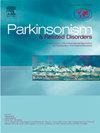Sex differences in the pharmacokinetics of levodopa and carbidopa in patients with Parkinson's disease
IF 3.4
3区 医学
Q2 CLINICAL NEUROLOGY
引用次数: 0
Abstract
Introduction
Levodopa pharmacokinetics exhibit substantial interindividual variability. Sex has been recognized as a contributing factor, with female patients frequently showing higher plasma levodopa concentrations than male patients. However, data on the pharmacokinetics of aromatic L‒amino acid decarboxylase (AADC) inhibitors such as carbidopa, which are co‒administered with levodopa, remain limited. This study aimed to evaluate the impact of sex and other variables on the pharmacokinetics of both levodopa and carbidopa in patients with Parkinson's disease (PD).
Methods
We conducted a retrospective analysis of patients with PD who underwent pharmacokinetic evaluation following the administration of an oral levodopa/carbidopa formulation in the fasting state. Pharmacokinetic parameters, including maximum plasma concentration, time to reach the maximum concentration, and the area under the plasma concentration‒time curve (AUC), were calculated. Multiple regression analysis was performed to identify factors associated with AUC.
Results
A total of 42 patients (21 males, 21 females; mean age 72.88 ± 7.51 years) were included. The AUC of levodopa was significantly higher in female patients than in male patients (p = 0.017), while no significant sex‒related differences were observed in the pharmacokinetics of carbidopa. Multiple regression analysis estimated that female sex was associated with a 21.9 % increase in levodopa AUC compared to male sex.
Conclusions
Our findings suggest that sex significantly influences levodopa pharmacokinetics but has little effect on carbidopa. Further studies are warranted to elucidate the mechanisms underlying this sex difference and to determine whether similar effects occur with other AADC inhibitors.
帕金森病患者左旋多巴和卡比多巴药代动力学的性别差异
左旋多巴的药代动力学表现出显著的个体差异性。性别被认为是一个影响因素,女性患者的血浆左旋多巴浓度通常高于男性患者。然而,芳香l -氨基酸脱羧酶(AADC)抑制剂(如卡比多巴)与左旋多巴联合使用的药代动力学数据仍然有限。本研究旨在评估性别和其他变量对帕金森病(PD)患者左旋多巴和卡比多巴药代动力学的影响。方法回顾性分析PD患者在禁食状态下口服左旋多巴/卡比多巴制剂后进行药代动力学评价。计算药代动力学参数,包括最大血药浓度、达到最大血药浓度所需时间、血药浓度-时间曲线下面积(AUC)。采用多元回归分析确定与AUC相关的因素。结果共纳入42例患者,男21例,女21例,平均年龄72.88±7.51岁。左旋多巴的AUC在女性患者中显著高于男性患者(p = 0.017),而卡比多巴的药代动力学在性别上无显著差异。多元回归分析估计女性与男性相比左旋多巴AUC增加21.9%相关。结论性别对左旋多巴药代动力学有显著影响,但对卡比多巴影响不大。需要进一步的研究来阐明这种性别差异背后的机制,并确定其他AADC抑制剂是否也会产生类似的效果。
本文章由计算机程序翻译,如有差异,请以英文原文为准。
求助全文
约1分钟内获得全文
求助全文
来源期刊

Parkinsonism & related disorders
医学-临床神经学
CiteScore
6.20
自引率
4.90%
发文量
292
审稿时长
39 days
期刊介绍:
Parkinsonism & Related Disorders publishes the results of basic and clinical research contributing to the understanding, diagnosis and treatment of all neurodegenerative syndromes in which Parkinsonism, Essential Tremor or related movement disorders may be a feature. Regular features will include: Review Articles, Point of View articles, Full-length Articles, Short Communications, Case Reports and Letter to the Editor.
 求助内容:
求助内容: 应助结果提醒方式:
应助结果提醒方式:


